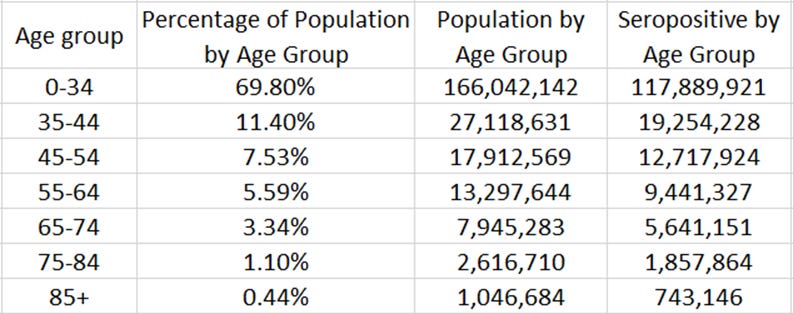How many lives were saved from COVID-19 in Uttar Pradesh during 2020 up till August of 2021?
Can we estimate how many approximately? Thankfully, we can.
Uttar Pradesh’s (UP) mass distribution of Ivermectin-based medical kits for prophylaxis and early treatment of COVID-19 have certainly saved many lives. In his recent articles dedicated to UP’s epic success, Part 1, Part 2 and Part 3, Dr. Pierre Kory laid out the structure, function, and escalation of Uttar Pradesh’s “Test, Track, and Treat”, and the events at the Federal level in India during the time that UP was eradicating COVID.
But can we estimate how many lives have been saved approximately? It would be great to have a solid-data-supported idea about the effect size of this massive intervention by UP’s government. Luckily, it turns out, we have enough good data for analysis.
In order to estimate the number of lives saved from COVID-19 due to mass distribution of Ivermectin-based medical kits in UP during 2020 and 2021, we need two numbers:
Estimated number of COVID-19 deaths WITHOUT implementing mass distribution of medical kits.
Both reported and estimated number of actual COVID-19 deaths WITH implementing mass distribution of medical kits.
Let’s start with the easier task, the WITH number.
Number of actual COVID-19 deaths
Leffler et al. published a paper [Leffler 2022] analyzing excess and COVID-19 mortality in all Indian states for the period 2020 up until August of 2021. In Table 1 of this paper, we can locate both the official reported and estimated number of COVID-19 deaths in Uttar Pradesh for that period:
Reported number: 22,820
Estimated number: 56,810
Number of hypothetical COVID-19 deaths (if no intervention has happened)
To have as precise estimate for this number as possible, we take several data inputs:
The population of Uttar Pradesh as of 2021 as per [Leffler 2022]
The distribution of UP’s population by age groups as per [UP census 2011]
The seroposivity of UP by August 2021 as per [UP Seropositivity 2021]
The distribution of SARS-CoV-2 infection fatality rate without treatment by age groups as per [Levin 2020]
Let us summarize the data we already collected:
UP’s population estimate: 237,882,725 [Leffler 2022]
Reported C19 deaths by August of 2021: 22,820 [Leffler 2022]
Estimated C19 deaths by August of 2021: 56,810 [Leffler 2022]
Seropositivity by August of 2021: 71% [UP Seropositivity 2021]
According to the census conducted in 2011 (unfortunately, we don’t have more recent data), the population distribution of UP by age group looks as follows:
If we assume that the measured UP’s seropositivity of 71% was pretty much constant across all age groups, then we can generate the number of seropositive people by age groups:
Now, to compute the number of deaths per age groups, we need to have the infection fatality rates (IFR) without intervention for each age group. We obtain the IFR distribution by age from [Levin 2020]. Namely, Table 3 in this paper looks like as follows:
We insert this table into the Uttar Pradesh distribution table and we get the final table:
So, we computed the estimated COVID-19 deaths for each age group as well as the total, in the hypothetical case where people did not have access to any prophylaxis or early treatment. About 627 thousand people would have died of COVID-19 had there not been a massive operation of distributing life-saving medical kits state-wide.
Thus, as described in the introductory part, we have obtained the estimated number of COVID-19 deaths both WITHOUT and WITH implementing mass distribution of medical kits.
What now?
Well, let’s generate the summary table and see whether the mass distribution of medical kits for prophylaxis and early treatment had any effect, and if it did, what was the size of that effect.
The summary table says that if the official number of COVID-19 deaths reported by the UP government is correct, then the number of lives saved from COVID-19 is estimated to be about 604 thousand, which represents 96% mortality reduction.
If we assume the more pessimistic data from [Leffler 2022] to be true, then the number of lives saved is about 570 thousand, which is 91% mortality reduction.
To sum it up, thanks to the massive operation planned, organized and implemented by the Uttar Pradesh’s government comprising door-to-door distribution of medical kits containing Ivermectin, Doxycycline, Zinc, Vitamin D, and other medications or supplements, somewhere between 91% and 96% of the Uttar Pradesh people who, if not treated, would certainly have died from COVID-19, fortunately survived.
This is an epic success story!
REFERENCES
[Leffler 2022] Leffler, Christopher T., et al. "Preliminary analysis of excess mortality in India during the COVID-19 pandemic." The American Journal of Tropical Medicine and Hygiene 106.5 (2022): 1507. https://www.ncbi.nlm.nih.gov/pmc/articles/PMC9128677/
[UP census 2011] https://statisticstimes.com/demographics/india/uttar-pradesh-population.php
[UP Seropositivity 2021] https://www.indiatoday.in/coronavirus-outbreak/story/seropositivity-seroprevalence-antibodies-covid-mp-highest-kerala-lowest-icmr-fourth-national-sero-survey-1833787-2021-07-28
[Levin 2020] Levin, A.T., Hanage, W.P., Owusu-Boaitey, N. et al. Assessing the age specificity of infection fatality rates for COVID-19: systematic review, meta-analysis, and public policy implications. Eur J Epidemiol 35, 1123–1138 (2020). https://doi.org/10.1007/s10654-020-00698-1








